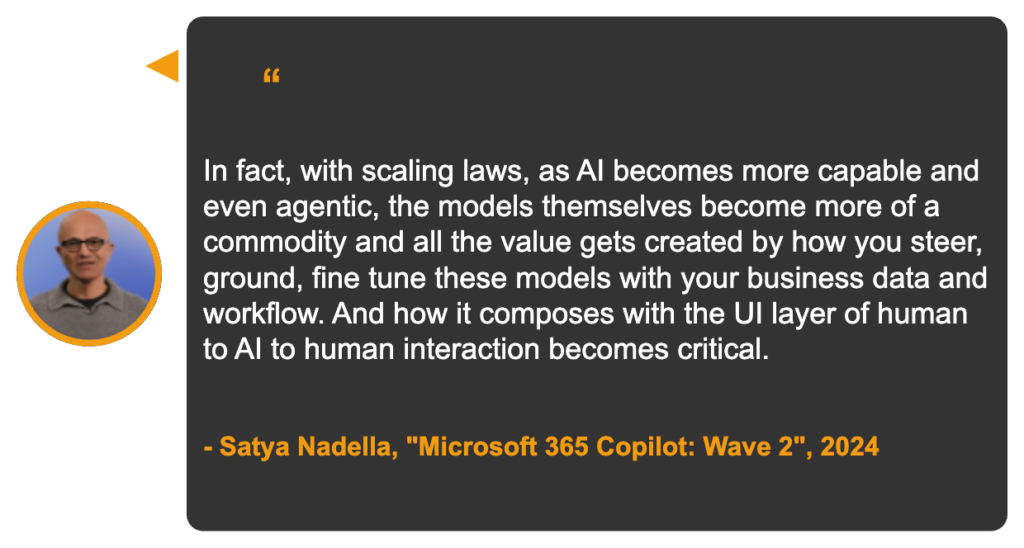At the heart of the September 2024 “Microsoft 365 Copilot: Wave 2” event, Satya Nadella shared a powerful insight:
“In fact, with scaling laws, as AI becomes more capable and even agentic, the models themselves become more of a commodity and all the value gets created by how you steer, ground, fine-tune these models with your business data and workflow. And how it composes with the UI layer of human to AI to human interaction becomes critical.”
– Satya Nadella, “Microsoft 365 Copilot: Wave 2”, 2024
This statement underscores the shifting role of AI in the enterprise. It’s no longer just about having cutting-edge models; rather, the key differentiator is how those models are customized and fine-tuned with real-world business workflows. As AI matures, its true value lies in its seamless integration with human tasks, which places tremendous importance on the user interface.
The UI for AI: Beyond the Model
Nadella’s comment invites us to reconsider how we interact with AI systems. The “UI layer of human-to-AI-to-human interaction” becomes a pivotal element. With features like Copilot Pages — a persistent, multiplayer canvas for AI collaboration—we’re seeing a new design system for knowledge work, where teams can work with AI as if it’s a collaborative partner. This new interaction model allows users to work alongside AI, refining outputs, and contributing human creativity and oversight in real-time. It’s not just about automation but about creating a seamless flow between human and machine to enhance productivity (a notable shift from previous AI systems).
Here are some of the event’s standout features that align with Nadella’s vision:
- Copilot Agents: These agents are customizable AI entities that can assist with specific tasks within apps like SharePoint and OneDrive. Users can create agents tailored to their workflows, saving time and improving team collaboration by allowing agents to reason over organizational content.
- Python Integration in Excel: A breakthrough feature that integrates Python within Excel, allowing users to run complex data analyses and machine learning tasks through natural language prompts. This innovation exemplifies the blend of advanced AI tools with user-friendly interfaces, democratizing data science capabilities for non-experts
- Copilot Pages: A dynamic, persistent workspace for AI collaboration, Copilot Pages transforms ephemeral AI content into durable assets that can be edited, shared, and iterated upon in real-time. This is an entirely new work pattern—multiplayer human-to-AI-to-human collaboration

Nadella’s quote suggests a future where AI is not just a back-end powerhouse but a partner embedded into the tools we use daily. The focus will shift more toward how we interact with AI, fine-tuning it to fit our unique business needs. As we move into this new phase of AI, the design and usability of the tools we build around it will define its success in enhancing productivity and unlocking new possibilities.
As we reflect on these advancements, it’s also critical to consider the governance and lifecycle management of AI, especially in business environments. Whether you are implementing Microsoft Copilot or other AI solutions, ensuring AI governance and managing its lifecycle is essential. You can explore more about these topics at ALMBoK.com and see how AI governance, AI lifecycle management, and AI Augmented development practices apply to all AI implementations, not just Microsoft Copilot. These principles are the foundation for building AI systems that are not only reliable and ethical but are also designed to drive meaningful business outcomes—ensuring success today and in the future.